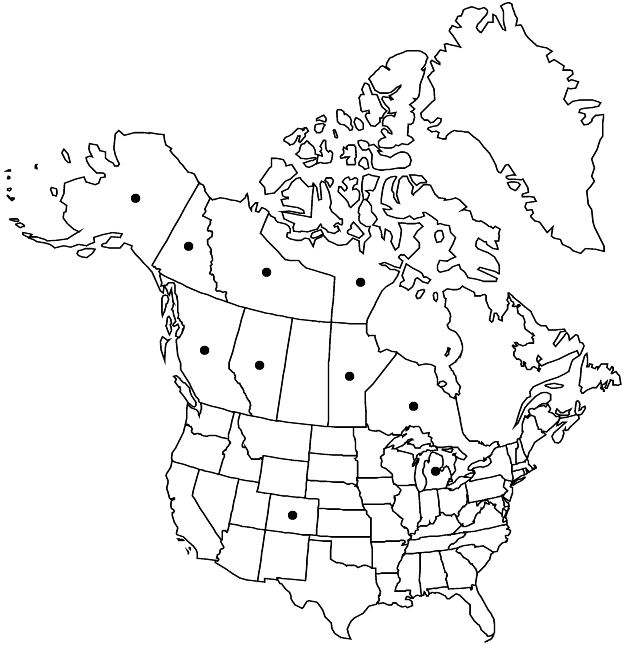Viola epipsila var. repens
J. Bot. Res. Inst. Texas 4: 225. 2010.
Plants perennial, acaulescent, stoloniferous, 0.5–20 cm; stolons pale, often rooting and leafy at nodes; rhizome slender, fleshy. Leaves basal, 1–4, ascending to erect; stipules linearlanceolate, margins entire, apex acute; petiole 1–5 cm, glabrous or pubescent; blade unlobed, broadly ovate, reniform, or orbiculate, 1.5–2.5 (–4.5) × 2–3 (–4) cm, base cordate, margins crenate, denticulate, or entire, ciliate or eciliate, apex rounded to obtuse, sometimes acute, surfaces glabrous or sparsely pubescent throughout or abaxially. Peduncles 2–7 cm, glabrous or pubescent, bracteoles usually above middle in chasmogamous flowers. Flowers: sepals ovatelanceolate, margins ciliate or eciliate, auricles 1–2 mm; petals lilac, violet, or deep purple on both surfaces, sometimes nearly white, lowest dark violet-veined, lateral 2 bearded or beardless, lowest 12–15 mm, spur same color as petals, gibbous, 1–2 mm; style head beardless; cleistogamous flowers on ascending peduncles. Capsules ellipsoid, 5–10 mm, glabrous. Seeds beige, 1.4–1.6 mm. 2n = 24, 36.
Phenology: Flowering May–Aug.
Habitat: Swamps, bogs, marshes, along streams, mossy wet banks, cool, wet places
Elevation: 10–2000 m
Distribution

Alta., B.C., Man., N.W.T., Nunavut, Ont., Yukon, Alaska, Colo., Mich., Europe, Asia
Discussion
Viola epipsila occurs in small colonies; individual plants are interconnected by stolons.
Variety repens differs from var. epipsila by its smaller size, glabrous, abaxial leaf surfaces (V. B. Baird 1942), acute leaves, and larger flowers (M. Sorsa 1968). When flowering, usually only one or two leaves, rarely more, are present per caudex.
M. Sorsa (1968) noted that diploid plants in British Columbia and Washington differed morphologically from diploid plants in Alaska. J. G. Packer in G. W. Douglas et al. (1989–1994, vol. 3; 1998–2002, vol. 5) wrote that var. repens (as subsp. repens) (2n = 24) and V. palustris (2n = 48) intergrade in British Columbia and are often difficult to separate.
The presence of bracteoles above or below the middle of the peduncle has been used to differentiate Viola epipsila from V. palustris (V. B. Baird 1942; M. Sorsa 1968). B. A. Bennett (pers. comm.) reported that both varieties of V. epipsila at ALA collected in Alaska had bracteoles mostly above, but some occur at or below the middle of the peduncle. T. Marcussen and T. Karlsson (2010) stated that bracteoles of V. palustris occur in the middle third of the peduncle.
E. Hultén (1941–1950, vol. 7, 1968) considered Viola palustris synonymous with V. epipsila var. repens (as subsp. repens). He produced maps (Hultén 1968; Hultén and M. Fries 1986) showing the distribution of the taxon extending into the lower 48 states. Variety repens was first reported in the United States by H. E. Ballard (1985) stating that it had been documented in California, South Dakota, and Utah, apparently based on the 1968 map by Hultén, as well as in Michigan, where it is listed as endangered. At present, there is no evidence that var. repens occurs in California; M. Sorsa (1968) did not state that var. repens occurs in California and recently wrote that she could not say she had identified var. repens there (pers. comm.). S. L. Welsh et al. (1987) and N. H. Holmgren (2005d) did not recognize it as occurring in Utah.
The overall situation regarding the Viola palustris complex in the northwestern United States and southwestern Canada is complicated by the apparent presence of hybrids between V. epipsila var. repens and V. palustris, as commonly occurs in Europe and northern Asia (M. Sorsa 1968), and possibly with other species in the complex. Sorsa commented that the distinctly acute leaves of var. repens set it apart from V. palustris. A review of on-line images of var. repens at ALA (http://arctos.database.museum/SpecimenResults.cfm) of specimens collected in Alaska and scans of specimens collected by B. A. Bennett in Yukon show a range of apices from rounded to acute. Because meiosis and the number of chromosomes of V. achyrophora were identical to those of var. repens, Sorsa considered V. achyrophora to be a more northerly form of var. repens. The V. palustris complex in western North America, which includes V. blanda, V. epipsila var. repens, V. macloskeyi, V. palustris, and V. renifolia, is in need of detailed study.
Selected References
None.
Lower Taxa
"thick" is not a number. "narrow" is not a number.